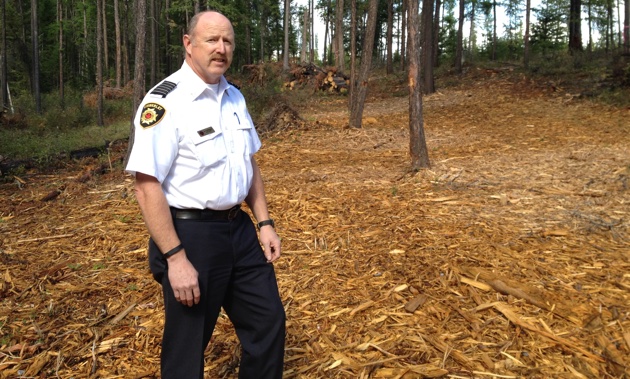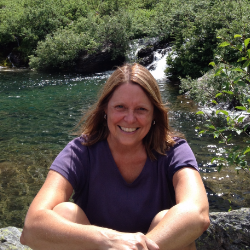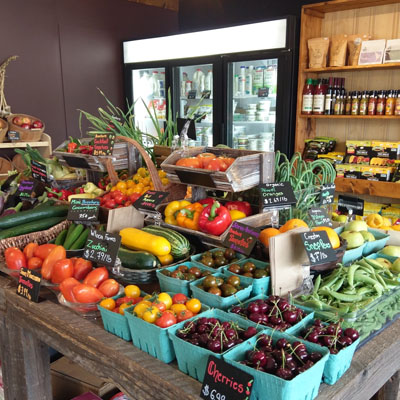The City of Kimberley tackles wildland fire risk
Kimberley Fire Chief Al Collinson explains the work and the risks

Kimberley Fire Chief Al Collinson inspects the work done at the Duck Pond Project, where fuels have been reduced through thinning and mastication. — Virginia Rasch photo
The very hot and dry conditions this summer in British Columbia have led to a challenging fire season. Some of our communities have done valuable work to reduce their fire risk in the wildland urban interface—that area where forests meet human development—by reducing hazardous fuels.
However, most communities in B.C. remain vulnerable to catastrophic wildfire, according to a May 2015 report by the Forest Practices Board. “Only about 10 per cent of high-risk forests around communities have received a fuel management treatment over the past decade,” stated the report. And the cost of treatment is estimated at $10,000 per hectare.
The City of Kimberley is an example of a community that has proactively managed its forest fuels in the interface zone by first creating the Kimberley Community Wildfire Plan Phases I to III through R.W. Gray Consulting, Ltd. and then implementing treatments. Typical forest treatments include thinning of the trees followed by piling and burning, or chipping and hauling.
Kimberley Fire Chief Al Collinson said the city began treatments in 2003, starting with city-owned lands and then expanding to the Kimberley Nordic Ski Area and the Nature Park. Over 365 hectares have been treated to date but at least 800 additional hectares need treatment.
For phases II and III, the estimated budgets totalled $6.7 million. Collinson said that some of the City’s treatments yielded merchantable timber that was sold.
“Those dollars were placed in a trust account and used to cover the City’s in-kind contribution towards (grants from the Union of BC Municipalities [UBCM]),” said Collinson. “Once that reserve was exhausted the City has annually appropriated $10,000 towards its in-kind contribution for grants from the UBCM.”
Collinson said that the City has “aggressively pursued any and all grants available.” These include UBCM Strategic Wildfire Prevention Initiative Operational Treatment Grants, Federal Mountain Pine Beetle Recovery Program Grants, Job Opportunities Program Grants, National Resource Canada grants and matching grant dollars from the Columbia Basin Trust for the City’s portion of the in-kind contribution.
“Local industry partners such as Teck and Tembec have carried out a number of treatments that have provided a great deal of benefit to the City,” Collinson said. “However, those areas—like those treated by the City—will require maintenance of re-accumulated fuels to maintain a low-hazard rating.”
Citizens and students of Selkirk Secondary School have participated in treatments as well.

Fire Chief Al Collinson appreciates the co-operation of Kimberley Nature Park volunteers to reduce wildland fire risks in the park through thinning of the forest. — Virginia Rasch photo
And, Collinson added, “The city adopted the FireSmart Program in the Official Community Plan and has also enacted a wildlife covenant stipulating that all new subdivisions receive a wildfire hazard assessment and adhere to FireSmart guidelines.”
Despite all the City’s efforts and expenditures, Kimberley is one of the most at-risk communities in the province, according to Collinson and the City’s consultants.
“Kimberley lies downwind and upslope of the pathway that fire has traditionally travelled (down the St. Mary’s River Valley), said Collinson. “Since 1917 the City has either burned, partially burned or narrowly escaped wildfires over 40 times. As the climate changes, areas to the west of town will experience more and more drought-stress resulting in higher tree mortality and an increase in fuels (there is already a significant fuel load problem due to mountain pine beetle mortality). This combined with a longer fire season will only place the community and area at higher risk.”
As consultant Bob Gray explained, “Our spatial fire behaviour analysis indicates that the narrow two-kilometre buffer that we’ve been working under is inadequate and only buys the City approximately 1.5 hours lead time to evacuate the community in the event a fire approaches the City from the south, southwest or west. To have a reasonable impact on the fire danger posed by a fire approaching the City from those quarters an additional 15,000 to 30,000 hectares need to be treated and maintained in a low-hazard state.”
That means many more resources are needed to reduce wildfire risks to Kimberley and other communities in B.C.
Collinson said that the Province and local government must find a way to reduce the cost of fuel treatments, to provide more grant money for fuel treatments and to develop an economical incentive to private landowners to treat fuel hazards on their property, especially large holdings. “Until those key problems are solved, the City will remain at very high risk for a substantial and costly interface fire,” he said.






Comments